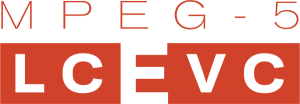Top Qs
Timeline
Chat
Perspective
LCEVC
Video coding standard From Wikipedia, the free encyclopedia
Remove ads
Low Complexity Enhancement Video Coding (LCEVC) is a ISO/IEC video coding standard developed by the Moving Picture Experts Group (MPEG) under the project name MPEG-5 Part 2 LCEVC.[1][2]
Remove ads
Concept
Summarize
Perspective
LCEVC specifies an enhancement layer which, when combined with a base video encoded with a separate codec, produces an enhanced video stream. The base layer is decodable by a hardware decoder, and the enhancement layer is suitable for software processing implementation with sustainable power consumption.[further explanation needed] The enhancement layer provides improved features to existing codecs, such as compression capability extension and lower encoding/decoding complexity, for live streaming or broadcasting applications.[3]
LCEVC leverages a base video codec (e.g., AVC, HEVC, VP9, AV1, EVC or VVC) and employs an efficient low-complexity enhancement that adds up to two layers of encoded residuals, along with normative signalled up-sampling methods, that correct artifacts produced by the base video codec and add detail and sharpness for the final output video.[4]
It provides additional compression efficiency to any existing or future video codec and reduces the processing complexity of encoding and decoding.[5][6]
LCEVC can be implemented with software updates for encoders and decoders, and was designed to leverage available hardware acceleration for graphics processing.[7]
Remove ads
Availability
It is possible for licensed users of the V-NOVA P+ codec to encode LCEVC files.[3]
History
Summarize
Perspective
In October 2018, MPEG issued a set of requirements for a new video coding standard and a Call for Proposals for Low Complexity Enhancement Video Coding.[8][9]
At IBC 2019 a preliminary implementation for encoding and decoding the forthcoming MPEG-5 Part 2 LCEVC was demonstrated.[10]
October 2020 at the 132nd MPEG meeting, LCEVC is completed reaching Final Draft stage.[11]
In April 2021, MPEG Video validated the Verification Test of LCEVC (Low Complexity Enhancement Video Coding) standard (ISO/IEC 23094-2). Test results tended to indicate an overall benefit also when using LCEVC to enhance AVC, HEVC, EVC and VVC.[12][13]
In May 2021, V-NOVA LCEVC Licensing Terms were announced for Entertainment Video Services. It is a software development kit and a wide range of reference integrations that add MPEG-5 Part 2 LCEVC (ISO/IEC 23094-2) encoding and decoding to any existing video delivery workflow. V-NOVA LCEVC is an implementation of MPEG-5 Part 2 LCEVC, the codec-agnostic (ISO/IEC) enhancement standard capable of providing higher quality at up to 40% lower bitrates than codecs used natively.[14][15]
As per Jan Ozer's report, LCEVC Technology entitled LCEVC x264 Report: Live Sports & eGames, ABR Ladder.[16]
In January 2022, SBTVD Forum approved a selection of technologies for SBTVD 3.0 which include MPEG-5 LCEVC, V-NOVA & Harmonic's submission.[17][18]
In January 2022, ISO/IEC published a set of tests and procedures to verify whether bitstreams and decoders meet normative requirements specified in the MPEG-5 LCEVC part 2 standard in order for implementers of LCEVC to be able to test the functioning and verify the conformance of their implementations.[19]
Stefano Battista, Guido Meardi, Simone Ferrara, Lorenzo Ciccarelli, Massimo Conti and Simone Orcioni are the co-authors of Low Complexity Enhancement Video Coding (LCEVC) Standard.[20] [21]
License
LCEVC is proprietary to V-Nova and subject to V-Nova's proprietary licence. Therefore, distribution of any pre-compiled subsystem is strictly prohibited, even between group companies.[22]
In August 2025, V-Nova rolled out two licensing programs for MPEG-5 LCEVC, with terms crafted for both video distribution services and consumer device makers. Public reporting indicates the service program bases royalties on active user counts (with a waiver for free-to-air broadcasting), while the device program starts at about US $0.20 per unit (and includes discounts for open-access configurations).[23]
Remove ads
Software support
FFmpeg version 7.1[24] officially supports decoding using official external library: LCEVCdec.[25]
GStreamer supports LCEVC since version 1.26 released on March 11, 2025.[26]
See also
- MPEG-5 Part 1 / Essential Video Coding / EVC
- H.266 / MPEG-I Part 3 / Versatile Video Coding / VVC especially Joint Layer Reference
- Layered coding
- Bitrate peeling
- Hierarchical modulation
- Backward compatibility, in which newer systems can understand data generated by older ones
- Forward compatibility, in which older systems can understand data generated by newer ones
- Compatibility layer, components that allow for non-native support of components
- Compatibility mode, software mechanism in which a software emulates an older version of software
Remove ads
References
External links
Wikiwand - on
Seamless Wikipedia browsing. On steroids.
Remove ads

